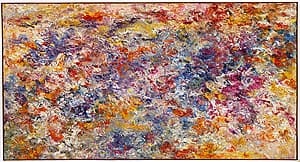

Jon Schueler
Learn moreThe first day 1956
© Jon Schueler Estate Gift of Andrew Salvesen 2010
More detail | PermalinkJon Schueler was a highly accomplished painter, although not as well-known as many other Abstract Expressionist artists. After a period in the Air Force, Schueler started painting, studying formally at the California School of Fine Arts under Clyfford Still and Richard Diebenkorn. There he also encountered Ad Reinhardt and Mark Rothko as visiting teachers. Moving to New York in 1951, Schueler met many prominent artists of the New York School, including Franz Kline, Joan Mitchell and Philip Guston.
Schueler was the first artist to have a solo show at the Leo Castelli Gallery in 1957, the year it opened: The first day 1956 was included in this exhibition. Possibly the most ambitious subject ever attempted, the title refers to the creation of the Earth as narrated in the opening verses of the Bible (Genesis 1: 1–5):
1: In the beginning God created the heaven and the earth ... 4: And God saw the light, that it was good: and God divided the light from the darkness. 5: And God called the light Day, and the darkness he called Night. And the evening and the morning were the first day.
Conventional Romantic depictions of the subject, such as that of nineteenth-century British painter John Martin, use deep black and blazing white to show the division of light from darkness. In contrast, Schueler renders the dazzling beauty of light as it is divided into colour. Theories about perception, the chemistry of paint and the meaning of colour become important in his realisation of such a difficult subject.
The immaterial becomes material. Blues and yellows are contrasted with hues of orange, red and purple, all made with myriad small strokes from a palette knife. The technique imbues the paint with a rhythmic, nervous quality so that the colours flicker before our eyes. The first day has rich impasto and the large canvas imparts a joyous effect, which changes according to the distance between the painting and the viewer.
Schueler’s exhibition at the Leo Castelli Gallery appeared to announce a new star in the firmament of the New York School. But, perhaps due to the maturing of the second generation of Abstract Expressionists—Helen Frankenthaler, Barnett Newman, Morris Louis—or the complications of his turbulent private life, Schueler’s increasingly individual trajectory of sky subjects and Turneresque Romanticism placed him outside the circle. The first day anticipates the artist’s development into a modern landscape painter of transcendent scenes.
Christine Dixon

